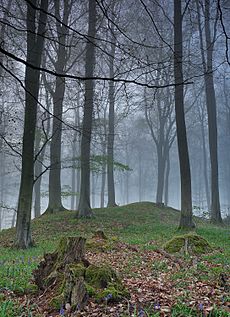Micheldever Wood facts for kids
Micheldever Wood is a beautiful forest located close to the village of Micheldever in Hampshire, England. It's about 5 miles (8 km) north-east of Winchester. This amazing woodland is looked after by Forestry England. It's not just a pretty place; it also holds secrets from long ago! You can find ancient remains from the Bronze Age and even a Roman villa here.
Contents
Exploring Micheldever Wood
Micheldever Wood covers a large area of 251.4 hectares (about 621 acres). The M3 motorway runs along its western side. The wood is mostly filled with tall beech trees. You'll also see some conifer trees mixed in.
There's a car park where you can leave your vehicle. You'll find nice picnic spots to enjoy your lunch. There are also two walking trails, perfect for exploring the forest.
Wildlife and Nature
Micheldever Wood is home to many different kinds of wildlife. You might spot muntjac deer roaming around. In the spring, the forest floor transforms into a stunning blue carpet. This happens when the bluebells bloom, creating a truly memorable sight.
A Look at the Wood's History
This area was once part of the Royal Forest of Pamber. That was during the medieval period, a very long time ago. Later, a part of what is now Micheldever Wood belonged to Hyde Abbey.
The abbey was closed down in the 1500s. After that, Micheldever Wood was bought by Thomas Wriothesley, 1st Earl of Southampton. It then passed down through families, eventually belonging to the Dukes of Bedford. In 1801, Sir Francis Baring, 1st Baronet bought the wood.
In the 1820s, a writer named William Cobbett described it. He wrote in his book Rural Rides that it was "one of the finest oak woods in England." Since 1919, Micheldever Wood has been cared for by the Forestry Commission.
Ancient Discoveries and Archaeology
Micheldever Wood is special because it has many ancient features. These date from the Bronze Age all the way to the Romano-British period. The forest has protected these remains for hundreds of years. These ancient sites are so important that they are now a scheduled monument. You can find information boards in the wood that explain some of these features.
Bronze Age Features
In the south-east part of the wood, there's a cross dyke from the Bronze Age. This earthwork extends into Itchen Wood nearby. Experts believe it marked an old boundary between territories. It's a bank about 3 meters (10 feet) wide. It has a ditch on both sides. The part of the dyke in Micheldever Wood is about 90 meters (295 feet) long.
You can also find a linear earthwork that runs west to east across the wood. Close by, there's a bowl barrow. This is a round burial mound, about 25 meters (82 feet) across and 2 meters (6.5 feet) high. It has a hollow in the middle from an old excavation. There's also a bell barrow, which is 23 meters (75 feet) wide and 1.8 meters (6 feet) high.
Iron Age Settlements
The wood also contains two banjo enclosures. These are ancient sites from the middle British Iron Age. They were likely used as places where people lived or kept their animals. One enclosure is 0.2 hectares (0.5 acres) in size, and the other is 0.3 hectares (0.7 acres). Both have entrances facing east.
Roman Villa Remains
There's a lot of evidence of a Romano-British settlement here. In the 1840s, over 1400 Roman coins were found. These coins were from the late fourth century. Other ancient objects and parts of old walls were also discovered.
In 1992, a survey recorded the remains of an L-shaped Roman villa. There were also other buildings connected to it. Around these, you can see traces of old garden terraces and pathways. Two trackways connect this settlement to the Roman road that ran between Winchester and Silchester.



